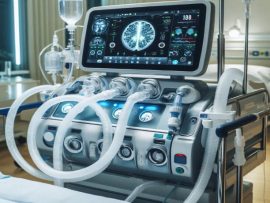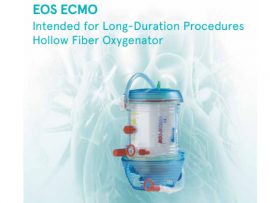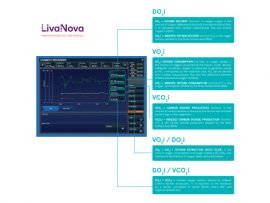Abstract Extracorporeal carbon dioxide removal (ECCO2R) is an emerging technique designed to reduce carbon dioxide (CO2) levels in venous blood while enabling lung-protective ventilation or alleviating the work of breathing...
Lire la suiteAbstract Normothermic regional perfusion (NRP) is a surgical technique that can improve the quality and number of organs recovered for donation after the determination of death by circulatory criteria. Despite..
Lire la suiteAbstract Controlled donation after the circulatory determination of death (cDCDD) has emerged as a strategy to increase the availability of organs for clinical use. Traditionally, organs from cDCDD donors have..
Lire la suiteAbstract Purpose of review Venovenous extracorporeal membrane oxygenation (VV-ECMO) provides gas exchange for patients with advanced respiratory failure who cannot maintain adequate oxygenation or carbon dioxide (CO2) clearance through conventional..
Lire la suiteAbstract Objectives Patents with out-of-hospital cardiac arrest (OHCA) are at high risk of death or poor neurologic recovery if spontaneous circulation is not rapidly restored. Emergent mechanical circulatory support with..
Lire la suiteAbstract Introduction Lung transplantation has been evolving since its inception in 1963. Over recent years, literature has suggested a shift in the perioperative strategy of mechanical support toward extracorporeal membrane..
Lire la suiteAbstract Venovenous (VV) extracorporeal membrane oxygenation (ECMO) supports end-organ oxygen delivery in patients with refractory respiratory failure. Physical therapy (PT) while on ECMO provides conceptual benefits of strength and conditioning...
Lire la suiteAbstract The mechanical circulatory support (MCS) for pediatric patients with severe acute heart failure and poor pulmonary conditions is challenging. Herein, we report the first pediatric case of successfully treated..
Lire la suiteAbstract Background Veno-arterial (V-A) and veno-venous (V-V) extracorporeal membrane oxygenation (ECMO) are crucial support modalities during lung transplantation, yet their comparative effectiveness remains unclear. Methods We conducted an 8-year retrospective..
Lire la suiteAbstract Extracorporeal membrane oxygenation (ECMO) can support patients with severe cardiorespiratory failure presenting with hypoxia who would otherwise have not survived. Patient selection for ECMO is challenging and relies on..
Lire la suiteAbstract Background. The global shortage of solid organs for transplantation is exacerbated by high demand, resulting in organ deficits and steadily growing waiting lists. Diverse strategies have been established to..
Lire la suiteAbstract Background Cardiac surgery patients are at increased risk for venous thromboembolism (VTE). Prevention is the most critical strategy to reduce VTE-associated morbidity and death. However, there is a lack..
Lire la suiteAbstract In recent years, there has been an increased utilization of temporary mechanical circulatory support (tMCS) in patients with cardiogenic shock (CS), with many transitioning to recovery or advanced therapies..
Lire la suiteAbstract Background: Lung transplantation (LTx) is a critical intervention for patients with end-stage lung disease. However, challenges such as donor organ scarcity and post-transplant complications significantly affect its success. Recent..
Lire la suiteAbstract BACKGROUND Donor stagnation and modification of lung allocation scores has resulted in a higher acuity of patient presentation prior to lung transplantation. Extracorporeal membrane oxygenation (ECMO) has been utilized..
Lire la suiteAbstract Heart transplantation (HT) is markedly constrained due to a critical shortage of suitable organs from donors in brain death (DBD). Transplantation of hearts donated after circulatory death (DCD) has..
Lire la suiteAbstract Aim This meta-analysis aimed to compare the outcomes of extracorporeal membrane oxygenation (ECMO) and cardiopulmonary bypass (CPB) in lung transplantation. Methods We searched PubMed, Embase, and Cochrane databases for..
Lire la suiteAbstract Background Congenitally corrected transposition of the great arteries (ccTGA) is a rare cardiac anomaly. The management strategy historically consisted of physiologic repair, leaving the morphologic right ventricle to support..
Lire la suiteAbstract Introduction Recently, there has been growing experience with utilizing a veno-arterial extracorporeal membrane oxygenator (VA ECMO) routinely during lung transplantation procedures. Yet, there is a lack of consensus on..
Lire la suiteAbstract We performed a retrospective review comparing outcomes between traditional ice storage (ICE) with short ischemic times (<3 hours) to SherpaPak Cardiac Transport System (SCTS) with long ischemic times (>4..
Lire la suiteAbstract Left ventricular assist devices (LVAD) have improved mortality and quality of life for patients with end-stage heart failure by providing an alternative to cardiac transplant or as a bridge..
Lire la suiteAbstract Under the revised UNOS heart allocation system, waitlist and post-transplant outcomes among patients bridged to transplant with VA-ECMO (BTT-ECMO) have improved. However, it remains largely unknown if these early..
Lire la suiteAbstract Open-lung ventilation during cardiopulmonary bypass (CPB) in patients undergoing heart transplantation (HTx) is a potential strategy to mitigate postoperative acute respiratory distress syndrome (ARDS). We utilized an ovine HTx..
Lire la suiteAbstract Heart transplantation (HT) is the gold standard treatment of end-stage heart disease. Waitlist mortality remains high due to a shortage of available donor organs. Donation after circulatory death (DCD)..
Lire la suiteAs the field of organ transplantation continues to evolve, the use of Donation after Circulatory Death (DCD) donors has emerged as a critical method to expand the donor pool. However,..
Lire la suiteAbstract Introduction Veno-venous extracorporeal membrane oxygenation has increasingly been utilized to support patients in respiratory failure as a bridge to recovery or lung transplantation. As patients progress from cannulation to..
Lire la suiteAbstract Background A common limitation to normothermic ex situ heart perfusion (ESHP) is functional decline. We previously designed a cardioprotective normothermic perfusion protocol, incorporating adenosine-lidocaine cardioplegia, subnormothermic reperfusion, pyruvate and..
Lire la suiteAbstract Background The pathology of primary hemostasis is a common complication of extracorporeal membrane oxygenation (ECMO) support. Scientific data describing its changes in patients on short-term ECMO support and the..
Lire la suiteAbstract The use of extracorporeal life support (ECLS) throughout the perioperative phase of lung transplantation requires nuanced planning and execution by an integrated team of multidisciplinary experts. To date, no..
Lire la suiteAbstract Extracorporeal membrane oxygenation is increasingly being used to support patients with hypoxemic respiratory failure and cardiogenic shock. During the COVID-19 pandemic, consensus guidance recommended extracorporeal life support for patients..
Lire la suite














